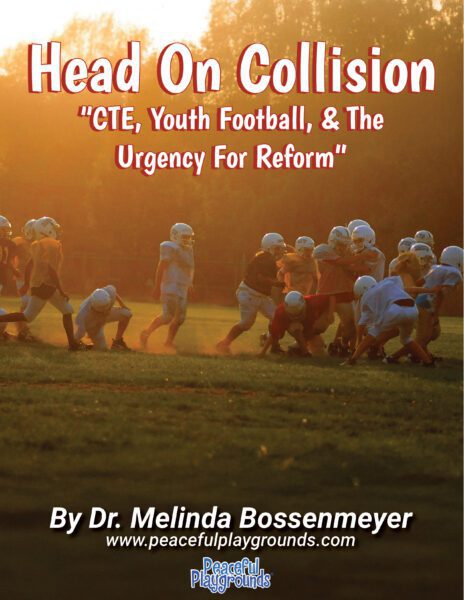Head on Collision: CTE, Youth Football and the Urgency of Reform
Amidst this backdrop, a potential paradigm shift is underway, fueled by new legislation in California
by Dr. Melinda Bossenmeyer, The Recess Doctor

By Dr. Melinda Bossenmeyer
History of CTE as it relates to Tackle Football
As we navigate the complex landscape of youth football, the looming specter of Chronic Traumatic Encephalopathy (CTE) casts an ever-growing shadow over the sport. For over two decades, I have echoed the concerns of the medical community regarding the unsettling correlation between repeated head impacts in tackle football and the insidious onset of CTE. The gravity of this condition gained widespread recognition in the early 2000s when Dr. Benet Omalu, a neuropathologist, unearthed the first case in an NFL player, Mike Weber of the Pittsburgh Steelers, during a postmortem examination. However, CTE's dark presence had already manifested in boxers many years prior.
Mike Weber's tragic demise ignited a profound sense of interest and concern, prompting intense scrutiny of the National Football League (NFL) and its policies. The subsequent multimillion-dollar settlement for NFL players and a surge in research intensified the investigation into CTE. The Center for Disease Control (CDC) has contributed valuable insights, exemplified by a study published in Sports Health. It exposes a stark reality –
youth tackle football athletes aged 6 to 14 endure 15 times more head impacts than their flag football counterparts during practices or games, with a staggering 23 times more high-magnitude head impacts. These impacts exponentially elevate the risk of concussions and other severe head injuries, particularly for our vulnerable youth.[1]
Amidst this backdrop, a potential paradigm shift is underway, fueled by new legislation in California. Intriguingly, Flag Football already boasts more participants in the 6-12 age group in America than tackle football. [2]Over a million children engage in youth sports flag football leagues, dwarfing the 724,000 in tackle football in 2022 (Sports and Fitness Industry Association). The momentum toward a ban on tackle football for children under 12 in California is gaining traction, driven by advocates determined to shield kids from the insidious specter of brain damage. This legislation, if passed, would position California as the pioneering state to prohibit tackle football for youths under 12, marking a watershed moment despite previous setbacks in similar attempts in California, New York, and Illinois.
Opposition to CA's Proposed Tackle Football Legislation
Yet, a chorus of opposition, primarily from coaches, argues that such a ban would rob youths of a vital source of physical activity. The rationale behind advocating for change is unequivocal. A wealth of research, articulated by Chris Nowinski, CEO of the Concussion Legacy Foundation, attests that tackle football induces brain damage, with the risk escalating proportionally to the duration of play. Chronic blows to the head give rise to Traumatic Encephalopathy, resulting in the irreversible death of nerve cells in the developing brains of our youth. Should this legislation pass, California stands poised to become the pioneer in prohibiting tackle football for youths under 12, marking a watershed moment despite previous setbacks in similar attempts in California, New York, and Illinois.
Do Kids Comprehend the Risks
A pivotal question looms large: do kids truly comprehend the risks, and do they engage in tackles with the intensity that could lead to life-altering consequences? A groundbreaking study[3] published in the neurology journal Brain delivers a resounding answer. It dispels the conventional wisdom that CTE arises solely from concussions and loss of consciousness, revealing a more insidious truth. The study suggests that repeated hits to the head, even without apparent symptoms, are far more detrimental and contribute significantly to the development of CTE—an unsettling revelation that resonates deeply in the context of our children's safety.
Despite a recent slight increase in high school-level tackle football participation in 2023, the overall trend signals a decline.[4] From 2015 to 2022, participation plummeted over 18%, a stark drop from 103,725 players to 84,626, as per the California Interscholastic Federation's participation survey. This decline underscores a growing awareness and a shift in attitudes toward the inherent risks posed by tackle football.
In the face of proposed legislation, there exists a faction opposing the changes. Tackle football coaches, youth leagues, and some parents argue that additional time is essential to effectively implement the 2021 California legislation, which already limits full-contact practices for high school and youth football teams during the offseason and restricts them to two practices per week during the season. Steve Famiano, a former youth football coach leading the Save Youth Football California Coalition, underscores the need for a measured adjustment period.
Safeguard the well-being of our youth and their future
In this critical juncture, the imperative to safeguard the well-being of our youth takes precedence. The evidence is mounting, and the trajectory of youth football is at a crossroads. The risks of CTE, especially among children engaged in tackle football, are undeniable, compelling us to reevaluate the balance between tradition and the profound responsibility we bear toward the health and future of the next generation.
[1] Comparing Head Impacts in Youth Tackle and Flag Football. Centers for Disease Control and Prevention. Sports Health Reports. CDC Head's UP Initiative. https://www.cdc.gov/traumaticbraininjury/pubs/youth_football_head_impacts.html#print
[2] Project Play. Core Sport Participation Select Sports, Ages 6-12. 2022. Aspen Institute. https://projectplay.org/youth-sports/facts/participation-rates
[3] Concussion, microvascular injury, and early tauopathy in young athletes after impact head injury and impact concussion mouse model. Brain, Vol. 141, Issue2, Feb. 2018, pages 422-458. https://doi.org/10.1093/brain/awx350
[4] State of Play 2023. Aspen Institute. Top 5 Participation Trends. #3 Tackle Football (27%) Flag football 32%). https://projectplay.org/state-of-play-2023/participation

